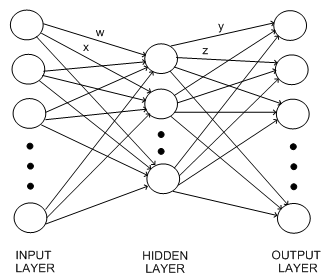Example of ANN - artificial intelligence:
ANNs look like this:

Notice that the x, w, z and y represent actual valued weights and that every the edges in this graph have weights associated with them (but it was hard to draw them all on). Notice also that more complexes ANNs are surely possible. In specific, several ANNs have multiple hidden layers, with the output from 1 hidden layer forming the input to another hidden layer. ANNs also with no hidden layer - where the input units are linked directly to the output units - are possible. These tend to be too simple to utilize for real world learning problems, but they are helpful to study for descriptive purposes, and we look at the simplest type of neural networks, perceptions, in the next section.
In the vehicle example, it is likely that the images will all be normalized to having the similar number of pixels. Then there can be an input unit for each blue,red and green intensity for each pixel. on the other hand, grayscale images can be used, in which case there needs just to be an input node for each pixel, which takes in the brightness of the pixel. The hidden layer is possible to contain far fewer units (probably between 3 and 10) than the number of input units. The output layer will contain 3 units, one for each of the categories possible (tank, car, bus). Then,
When the pixel data for an given image as the starting values for the input units, through the network ,this information will propagate and the 3 output units will produce a real value. The output unit which produces the largest value is taken as the categorization for the input image.
So, for example, when this image is used as input:

Then, if, output unit 2 [bus] produces value, output unit 1 [car] produces value 0.5 0.05 and the output unit 3 [tank] produces value 0.1, then this image has been (Correctly) classified like a car, because the output from the corresponding car output unit is larger than for the other 2. Accurately how the function embedded within a neural network computes the outputs given the inputs is excellent explained by using example networks. In the next section, we look at the simplest networks of all perceptrons, which contain of a set of input units connected to a single output unit.